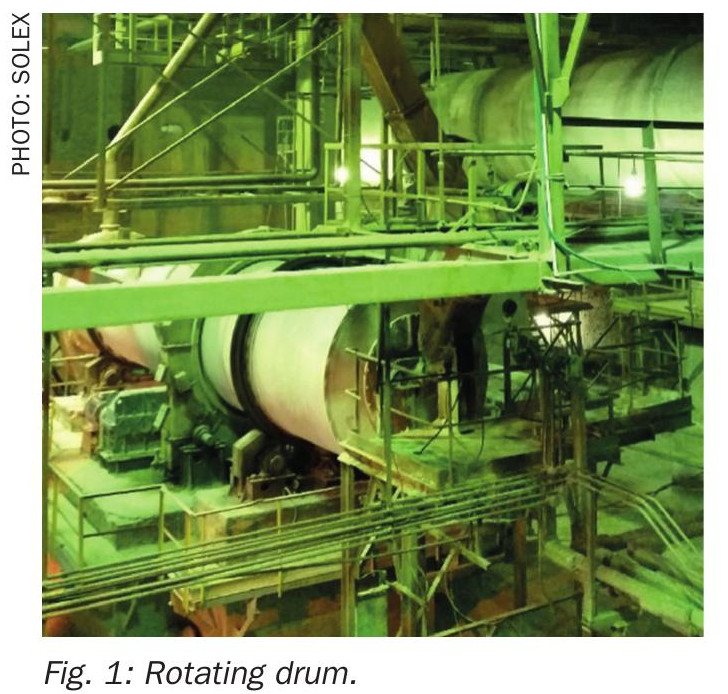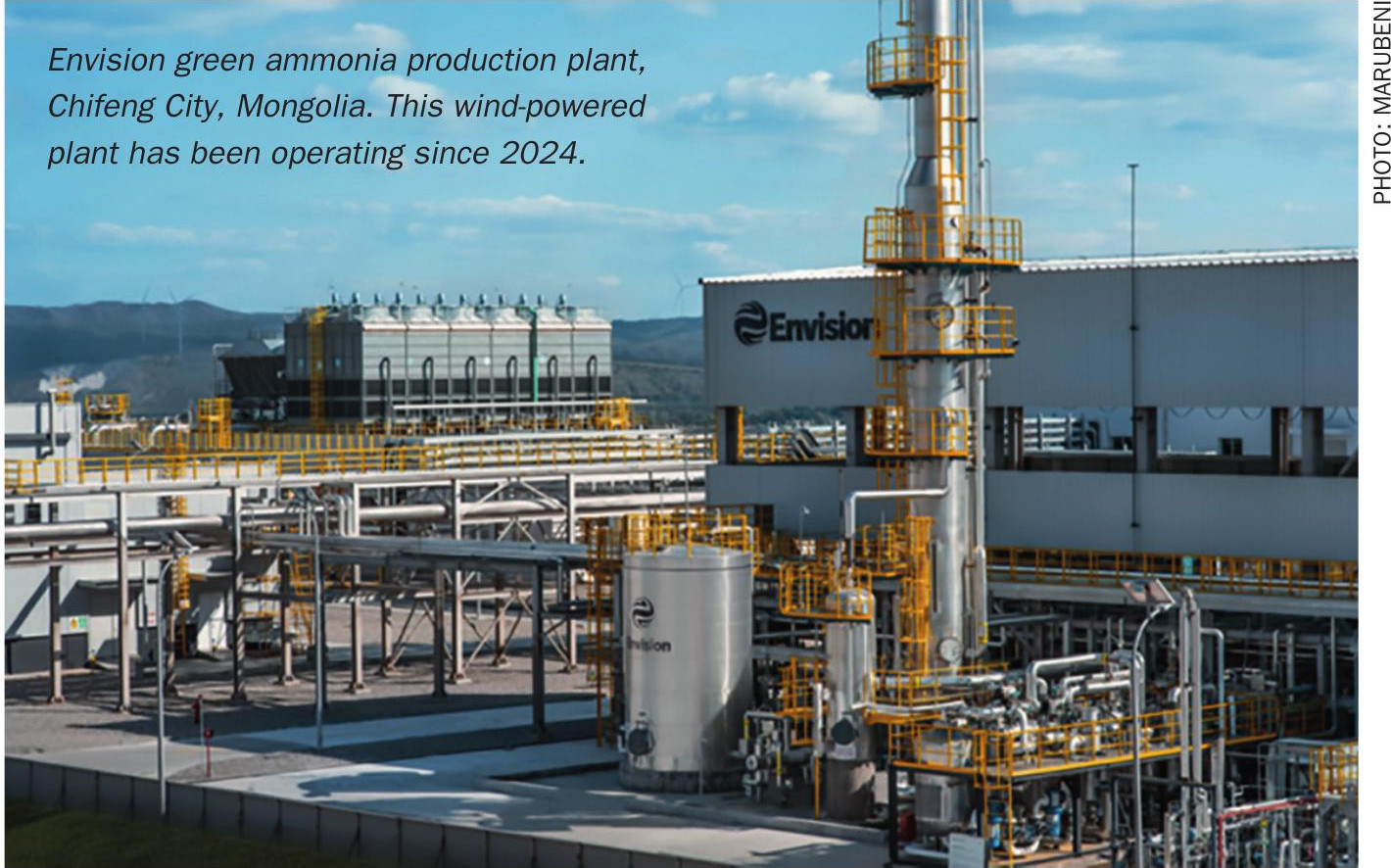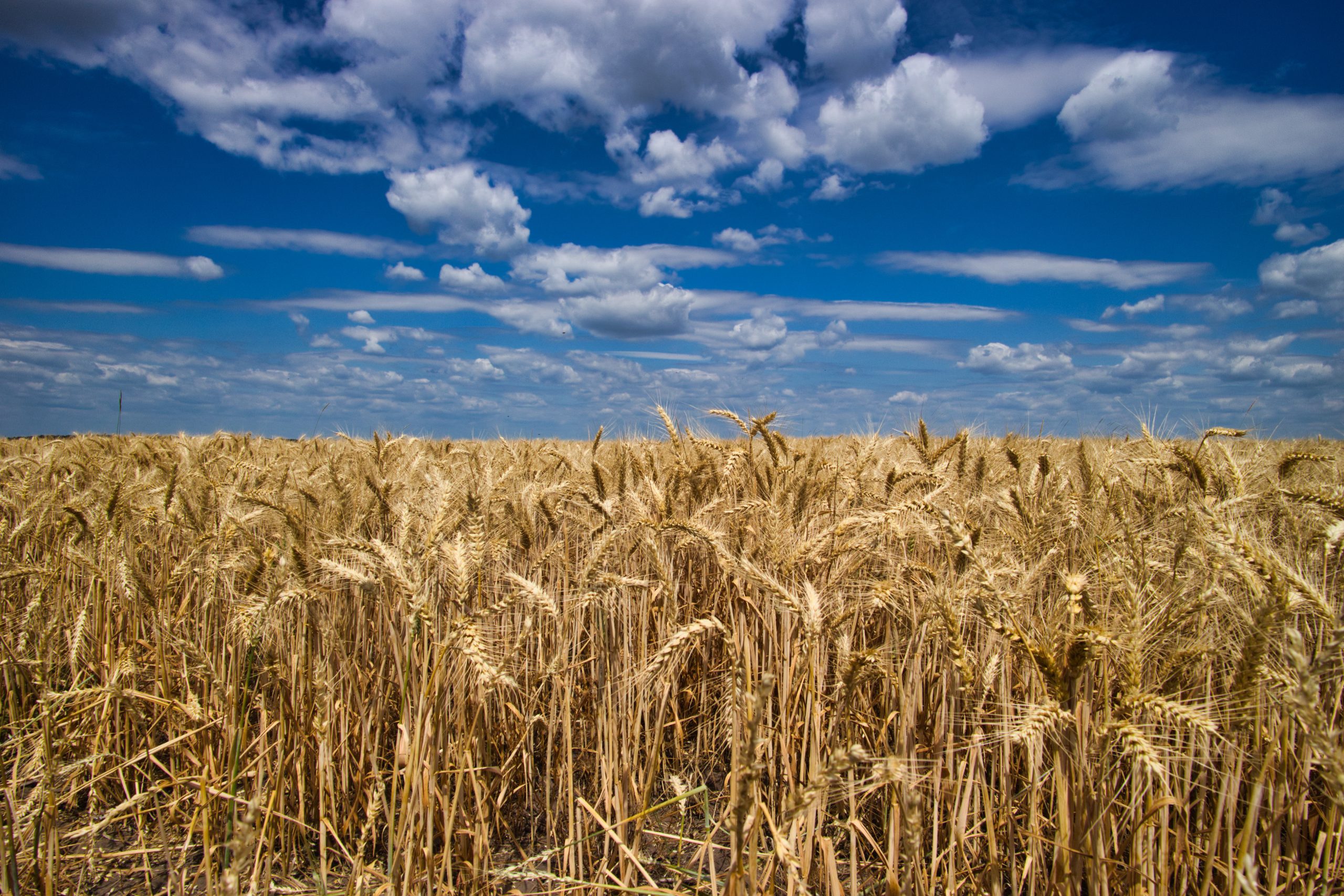Fertilizer International 526 May-Jun 2025

2 May 2025
Fertilizer financial scorecard – price falls hit earnings
COMPANY ANNUAL RESULTS
Fertilizer financial scorecard – price falls hit earnings
We compare and contrast the 2024 financial performance of selected major fertilizer producers following the publication of fourth quarter results.

Nutrien – higher sales volumes, lower earnings
Nutrien is the world’s largest crop nutrient company with a market capitalisation of more than $24 billion (Figure 1). The Canadian fertilizer giant combines manufacturing might with retail reach, producing around 25 million tonnes of potash, nitrogen and phosphate products annually from operations and investments in 13 countries, and then distributing these to agricultural, industrial and feed customers across the globe. Its agricultural retail business serves more than 500,000 farmers worldwide through 2,000 plus outlets across the Americas and Australia.

Nutrien’s revenues fell back by 11% year-on-year (y-o-y) in 2024 to $26.0 billion (Figure 2). Similarly, annual earnings (adjusted EBITDA) for the year declined by 12% to $5.4 billion (Figure 3). Free cash flow, a measure of profitability, ended 2024 at $1.4 billion (Figure 4), versus $2.4 billion for the preceding year.
While the company’s long-term debt remained stable – standing at $8.9 billion at the end 2024 (Figure 5) – net debt relative to earnings increased slightly, with a ratio of 2.2 compared to 1.9 for 2023.




Nutrien linked its 2024 earnings decline to lower realised potash and nitrogen selling prices, although these factors were partially offset by record potash sales volumes and higher earnings from its Nutrien Ag Solutions retail business.
Nutrien is the world’s largest potash producer. The company’s potash sales from its Canadian mines reached 13.9 million tonnes in 2024, a new annual record helped by low channel inventories and strong potash affordability in North America and other key markets. Of this volume, 9.2 million tonnes were shipped overseas with the remaining 4.7 million tonnes being sold within North America.
Potash accounted for 34% of Nutrien’s full-year earnings. The company’s potash earnings, at $1.8 billion (adjusted EBITDA) in 2024, were down 20% y-o-y, with lower realised selling prices cancelling out record sales volumes. The costs of goods sold (COGS) for potash fell slightly to $104/t last year, helped by a combination of higher production and greater mine automation.
Nutrien’s nitrogen earnings, meanwhile, fell by 2% in 2024 to $1.9 billion. Lower net selling prices offset higher sales volumes – 10.7 million tonnes in 2024 versus 10.4 million tonnes in 2023 – and lower natural gas costs. The average COGS for nitrogen products declined 9% y-o-y to $213/t in 2024, mainly because of cheaper North American natural gas.
Annual earnings at Nutrien’s retail business, Nutrien Ag Solutions, grew by 16% to $1.7 billion in 2024, boosted by higher product margins and lower costs. Crop nutrient product sales, however, were down 14 percent y-o-y at $7.2 billion due to lower selling prices and sales volumes.
Nutrien’s phosphate earnings declined by 18% y-o-y to $384 million. Falls in input costs for sulphur and ammonia raw materials failed to counter the hit to earnings from lower production volumes and weaker selling prices for industrial and feed phosphates.
Phosphate sales volumes fell back by 5% to 2.4 million tonnes last year, while the average COGS for phosphate products increased slightly (+3%) to $603/t. This was linked to lower production volumes and higher water treatment costs – a consequence of weather-related events, according to the company.
“Nutrien delivered higher upstream fertilizer sales volumes, accelerated operational efficiency and cost savings initiatives and increased downstream Retail earnings in 2024, demonstrating significant progress towards our 2026 performance targets,” said Ken Seitz, Nutrien’s president and CEO. “We took a disciplined and intentional approach, optimizing capital expenditures and returning $1.2 billion to shareholders through dividends and share repurchases.”
The company expressed confidence about 2025 market prospects.
“The outlook for our business in 2025 is supported by expectations for strong crop input demand and firming potash fundamentals. Nutrien has a world-class asset base, and we remain focused on strategic priorities that strengthen our core business and deliver structural improvements to our earnings and free cash flow,” Seitz said.
Yara bucks the trend with earnings growth
Norway’s Yara International, with a market capitalisation of $7.8 billion (Figure 1) and 18,000 global employees, is one of world’s largest crop nutrient providers, vying internationally with Nutrien for leadership on production and deliveries.
The Oslo-headquartered company produced 19.7 million tonnes of finished fertilizers and 7.2 million tonnes of ammonia from its global assets in 2024, achieving year-on-year growth of 7% and 12%, respectively. Finished fertilizer production included:
• 6.3 million tonnes of compound NPKs
• 5.9 million tonnes of nitrates
• 4.6 million tonnes of urea
• 1.7 million tonnes of calcium nitrate (CN)
• 0.9 million tonnes of urea ammonium nitrate (UAN)
• 0.2 million tonnes of single superphosphate (SSP).
Yara calculated that premium product sales in 2024 – namely its straight nitrate fertilizers and premium NPK offering – generated $1.4 billion in added-value, compared to the commodity fertilizer alternatives.

Yara’s product deliveries rose by 3% percent to 31.2 million tonnes last year. These were divided between:
• 22.9 million tonnes of fertilizers
• 6.5 million tonnes of industrial products
• 1.7 million tonnes of traded ammonia.
Yara’s annual revenues fell back by 11% y-o-y to $13.9 billion in 2024 (Figure 2), while earnings (EBITDA) – in contrast – bucked the general trend and grew by 10% to $1.9 billion (Figure 3). The earnings improvement – 20% higher y-o-y excluding special items – mainly reflected higher product deliveries and better margins following inventory write downs and position losses in 2023.
While Yara’s global deliveries increased by 3% overall in 2024, the regional picture was mixed:
• European deliveries were 14% higher compared with 2023, a year when the region was hit by both slow demand and production curtailments.
• In the Americas, 2023 deliveries fell by 4% compared with 2023, mainly due to less favourable farmer economics and disruptive flooding in Brazil, with these factors more than offsetting higher demand elsewhere in Latin and North America.
• Deliveries to Africa and Asia, meanwhile, were 2% higher in 2024, reflecting less production downtime from maintenance and outages.
Yara’s reported a y-o-y decline in full operating cash flow of $1.0 billion, primarily due to a larger release of operating capital in 2023 versus 2024. Free cash flow stood at $248 million at the year’s end (Figure 4). The company also saw its net debt position increase by $126 million to $3.7 billion in 2024 (Figure 5).
Announcing its full year results in February, Yara described 2024 as record year in production – and targeted higher free cash flow and better shareholder returns as its top priorities. The company’s total recordable injuries (TRI) notably fell to 0.9 per one million working hours at the end of 2024 – an all-time low.
Commenting on the company’s fourth quarter 2024 results, Svein Tore Holsether, Yara’s president and CEO, said: “Operational performance this quarter is strong, with record-high production and safety performance. This marks a significant milestone in our continuous work to improve safety and resilience in Yara. We’re also progressing well on our cost and capex reduction program, with a USD 90 million reduction achieved in 2024.”
Mosaic – signs of P&K volume recovery
Florida-headquartered The Mosaic Company is the world’s leading combined phosphate and potash producer with a market capitalisation of $7.9 billion (Figure 1). The company sold around 24.1 million tonnes of products in 2024 – down from 25.6 million tonnes in 2023 – with sales volumes split between three business segments:
- Potash segment: 8.7 million tonnes
- Phosphates segment: 6.4 million tonnes
- Mosaic Fertilizantes: 9.0 million tonnes.
Mosaic’s earnings fell back by 20% y-o-y to $2.2 billion (adjusted EBITDA) in 2024 (Figure 3). These results were achieved from full year revenues of $11.1 billion (Figure 2).
“We delivered our highest quarterly EBITDA of the year with great prospects for all three segments for 2025,” said Bruce Bodine, Mosaic’s president and CEO, commenting on the company’s fourth quarter and overall 2024 results. “Despite a series of operational and weather-related issues, which reduced our phosphate production by over 700,000 tonnes and potash production by about 250,000 tonnes in 2024, we see encouraging signs that we will deliver significant volume recovery in phosphates and potash in 2025 as we progress on projects to restore reliability.”
Phosphate earnings (adjusted EBITDA) were stable y-o-y at $1.2 billion in 2024, with higher selling prices and elevated stripping margins offsetting lower sales and production volumes. Mosaic’s phosphate sales volumes declined from 7.0 million tonnes in 2023 to 6.4 million tonnes in 2024, while the average diammonium phosphate (DAP) selling price rose by around $12/t to $585/t. Mosaic lost around 700,000 tonnes of phosphate production last year because of hurricanes and “other unusual events”, the company said.
The company’s potash earnings (adjusted EBITDA) totalled $0.9 billion in 2024, down from $1.5 billion in 2023, with this significant fall largely reflecting lower prices. In fact, versus 2023, Mosaic’s average MOP (muriate of potash) selling price fell by $86/t to $222/t in 2024, while its average gross potash margin for the year declined to $74/t, versus the more lucrative 2023 average of $137/t.
Mosaic’s potash sales volumes also decreased from 8.9 million tonnes in 2023 to 8.7 million tonnes in 2024, with the company citing third quarter “production challenges” at its Esterhazy and Colonsay mines as the cause of a 250,000 tonne production loss.
Full year earnings (adjusted EBITDA) at Mosaic’s Brazilian subsidiary Mosaic Fertilizantes, meanwhile, grew by 5% to $344 million in 2024. This earnings improvement reflected a strong underlying operating and cost performance, the company said. Mosaic Fertilizantes stopped importing phosphate rock in early 2024, for example, by shifting to domestic rock production instead. This change should deliver a $35-40 million annual production cost saving with $15 million of this already being realised in 2024.
Mosaic should be well positioned to benefit from improving market conditions in 2025, in Bruce Bodine’s view.
“We also made significant progress on our cost performance in the Mosaic Fertilizantes business, leading to the prospect of increased margins in 2025. With the conclusion of the Ma’aden deal and the signing of the Patos de Minas sale, we continue to execute our strategy to redeploy capital from non-core assets to our highest returning areas,” he said.
CF Industries highlights decarbonisation progress
Leading North American and UK nitrogen producer CF industries reported a modest decline in revenues and earnings in 2024. Full-year revenues ($5.9 billion) and earnings ($2.3 billion adjusted EBITDA) fell by 10% and 17% y-o-y, respectively (Figures 2 and 3). Despite these falls, CF’s 2024 earnings – like many of the major listed fertilizer producers featured in this article – still exceed pre-pandemic levels. Full year net cash from operating activities ($2.3 billion) and free cash flow ($1.4 billion, Figure 4) for 2024 also remain healthy.
CF highlighted the following company initiatives in its 2024 results:
• The completion of the front-end engineering and design (FEED) study on for the autothermal reforming (ATR) ammonia project with carbon capture and sequestration (CCS) at CF’s Blue Point Complex in Louisiana. The company expects to make a final project investment decision for the $4.0 billion project in the first quarter of 2025.
• The CCS project at CF’s Donaldsonville, Louisiana, complex is being commissioned and remains on track to start up this year. Completion of the project’s dehydration and compression unit will enable up to two million t/a of captured process carbon dioxide to be transported and permanently stored by ExxonMobil.
• The commissioning of the 20-megawatt alkaline water electrolysis plant at the Donaldsonville nitrogen complex, meanwhile, was paused in the fourth quarter of 2024 “due to an issue”.
• The signing of commercial agreement in July 2024 with ExxonMobil for the transport and permanent geological storage of up to 500,000 t/a of carbon dioxide as part of a CCS project at CF’s Yazoo City, Mississippi, production complex.
“CF Industries’ 2024 results reflect strong execution by our team against the backdrop of constructive global nitrogen industry dynamics,” said Tony Will, the company’s president and CEO. “We believe our cost-advantaged North American-based production network, operational capabilities and disciplined strategic initiatives position CF Industries well to continue to create substantial value for long-term shareholders.”
The Illinois-headquartered company has a market capitalisation of $13.0 billion (Figure 1). It attributed the 2024 decline in earnings to lower average selling prices, commenting that “lower global energy costs reduced the global market clearing price required to meet global demand”.
Average selling prices, representing all of CF’s nitrogen product segments, fell by 10% y-o-y to $425/t in 2024. This price level compares to average selling prices for the company of $473/t in 2023, $936/t in 2022, $498/t in 2021 and $271/t in 2020.
The company did, however, benefit from lower cost of sales in 2024, with this being linked to much lower natural gas costs. Its average natural gas cost last year was $2.40/MMBtu, versus annual averages of $3.67/MMBtu in 2023 and $7.18/MMBtu in 2022.
CF’s production volumes last year were relatively stable at 22.4 million tonnes, and included:
• 9.8 million tonnes of ammonia
• 4.4 million tonnes of granular urea
• 6.7 million tonnes of UAN (32%)
• 1.4 million tonnes of AN.
Total product sales volumes in 2024 were down slightly at 18.9 million tonnes versus 19.1 million tonnes for 2023.
ICL – focus on specialties and cash generation
Israel’s ICL Group is a leading producer of potash, phosphates and specialty fertilizers with a market capitalisation of around $7.9 billion (Figure 1). The company delivered annual sales of $6.8 billion, earnings (adjusted EBITDA) of $1.5 billion and free cash flow of $758 million in 2024 (Figures 2, 3 and 4).
While ICL’s earnings fell back by 16% last year, they remain elevated compared to the company’s pre-pandemic performance. ICL also highlighted the significant value delivered to shareholders in 2024, via more than $240 million in dividend payments, and the company’s strong cash flow generation.
“ICL delivered 2024 adjusted EBITDA of $1,469 million, with our specialtiesdriven businesses contributing 70% of that amount, as we continued to focus on cash generation while increasing market share across Industrial Products, Phosphate Solutions and Growing Solutions. We remain committed to growing our leadership position for these three businesses,” said Raviv Zoller, ICL’s outgoing president and CEO.
ICL’s Phosphate Solutions business ($549 million) and Potash ($492 million) business segments contributed 36% and 32%, respectively, to overall company earnings (EBITDA) in 2024. The Industrial Products segment ($281 million) also generated a 18% share of earnings, while ICL’s specialty fertilizer business, Growing Solutions, delivered the final 13% of earnings ($202 million).
ICL operates potash production assets in Israel (Dead Sea works) and Spain (Cabanasses mine). Total potash output in 2024 (4.5 million tonnes) was up by 82,000 tonnes y-o-y, mainly due to higher production in Spain. Potash sales (4.5 million tonnes) were 127,000 tonnes lower y-o-y, linked to a fall in sales to China and Brazil. ICL has, however, signed new contracts to supply its Chinese customers with 2.5 million t/a of potash between 2025-2027, with the option to supply an additional 960,000 tonnes during the three-year agreement.
Overall, ICL’s Potash business unit generated revenues of $1.7 billion in 2024, versus $2.2 billion in 2023. Revenues were affected by a fall in the average realised potash price (CIF) to $299/t last year, versus averages of $393/t in 2023 and $682/t in 2022.
Total revenues accrued by ICL’s Growing Solutions segment were $2.0 billion in 2024. This segment markets and sells the company’s controlled-release fertilizers (CRF), water-soluble fertilizers (WSF), liquid fertilizers and straights (MKP/MAP/PeKacid), polyhalite products (FertilizerpluS), soil and foliar micronutrients, secondary nutrients, biostimulants, soil conditioners, seed treatment products and adjuvants.
ICL uses phosphate rock and fertilizer-grade phosphoric acid to produce phosphate-based fertilizers and value-added specialty products. The company’s Phosphate Solutions business generated revenues of $2.2 billion in 2024.
“During 2024, amidst persistent potash price declines and geopolitical challenges, we achieved strong profitability and cashflow, introduced dozens of innovative specialties products, developed new global partnerships, set production records at multiple sites, completed complementary bolt-on acquisitions, and continued to be vigilant in the execution of cost savings and efficiency efforts, while continuing to drive significant value to our shareholders,” said Raviv Zoller. “As a result, we are entering 2025 in a solid position and looking forward to improving market conditions in key end-markets.”
Looking ahead, ICL expects its specialty business segments (Industrial Products, Phosphate Solutions and Growing Solutions) to deliver earnings (adjusted EBITDA) of around $0.95-1.15 billion in 2025. Total potash sales of 4.5-4.7 million tonnes are also forecast for this year.
K+S targets sustainable transformation
Revenues at K+S Aktiengesellschaft declined by 6% y-o-y to €3.7 billion (Figure 2), while earnings (EBITDA) for the year fell by 22% percent to €558 million (Figure 3). The company generated free cash flow of €62 million in 2024 (Figure 4) and, unusually for the sector, has been without net debt since the end of 2022 (Figure 5).
With a market capitalisation of $2.6 billion (Figure 1), K+S is western Europe’s largest potash producer, having a global market share of around nine percent. It also has a production presence in Canada, owning and operating the Bethune potash mine in Saskatchewan. The company is also growing its portfolio of specialty fertilizers. These products are chloride-free and/or supplement potassium with other elements such as magnesium, sulphur, sodium and micronutrients.
“We are on track and performed well despite low potash prices in 2024,” said Dr Burkhard Lohr, the chair of K+S. “Our strength are our integrated potash plants on both sides of the Atlantic as well as in our European salt business.
“With our global positioning and our specialties, we have demonstrated that we can implement our sustainable transformation under challenging conditions with our own resources. The Werra 2060 project and the ramp-up of our Bethune plant in Canada are fully on track,” Dr Lohr added.
The Werra 2060 project is designed to make Germany’s domestic potash production more sustainable and competitive by taking major steps towards production decarbonisation. The project will also extend the lifetime of the integrated Werra potash production plant. K+S recently launched a range of low-carbon potash and magnesium fertilizers as part of this decarbonisation shift.
In Canada, meanwhile, K+S plans to expand the production capacity of its Bethune potash plant – through secondary mining – to four million tonnes per annum. “This will gradually and significantly improve our cost position,” commented Dr Lohr.
Lower realised prices for potassium chloride (averaging €282/t in 2024 vs €360/t in 2023) and fertilizer specialities (averaging €362/t in 2024 vs €394/t in 2023) were a feature of 2024 market conditions. The company’s agricultural segment did, however, sell 7.9 million tonnes of fertilizer products in 2024, up significantly on the 7.3 million tonnes sold in 2023. This sales volume was divided between 4.35 million tonnes of potash and 3.55 million tonnes of specialty fertilizers.
K+S fertilizer products sold at an average price of €323/t in 2024 versus averages of €372/t in 2023, €628/t in 2022 and €298/t in 2021.
K+S is currently forecasting earnings (EBITDA) of €500-620 million for 2025. Reaching the upper end of this estimate assumes that Brazil’s potassium chloride price will recover during the spring season, compared to the mid-February 2025 price, with this price level then spilling over into other markets during the second half of the year; it also assumes agriculture segment product sales of 7.7 million tonnes.

OCI Global – leaner and agile with $11.6bn in proceeds
Netherlands-headquartered OCI Global drastically restructured in the second half of last year via a series of strategic divestments. These included the sale of:
• OCI Methanol to Methanex (announced but not completed)
• OCI’s entire Fertiglobe equity stake to ADNOC
• Iowa Fertilizer Company (IFCo) to Koch Industries
• OCI Clean Ammonia to Woodside Energy.
“These transactions will collectively amount to over $11.6 billion in gross proceeds, which has allowed us to repay approximately $1.8 billion in debt and return $3.3 billion in cash distributions to shareholders,” said Hassan Badrawi, OCI Global’s CEO. “An additional cash distribution of up to $1 billion is further planned for Q2 2025, subject to the necessary approvals.”
The company reported revenues of $4.1 billion and earnings (adjusted EBITDA) of $826 million in 2024, compared to totals of $5.1 billion and $1.2 billion, respectively, in 2023 (Figures 2 and 3). These financial results do, however, include substantial revenues and earnings from operations which will be discontinued in future as a consequence of the above divestments.
Financial results for continuing operations are more relevant to OCI’s new streamlined company structure. Earnings (adjusted EBITDA) for OCI’s European nitrogen business – its sole remaining operating segment – were $55 million in 2024, for example, compared to an earnings loss of $51 million in 2023. Earnings recovered last year due to higher sales volumes and lower average natural gas prices, according to OCI.
OCI’s total fertilizer sales in 2024 were down 13% y-o-y at 7.4 million tonnes, with this total divided between:
• 1.8 million tonnes of ammonia
• 3.3 million tonnes of urea
• 1.0 million tonnes of calcium ammonium nitrate (CAN)
• 1.2 million tonnes of urea ammonium nitrate (UAN).
Stripping out divestments from this total, continuing operations accounted for a sales volume of 1.8 million tonnes in 2024, divided between CAN (58%), ammonia (24%) and UAN (18%).
Looking ahead to 2025, Hassan Badrawi said OCI’s priority would be to capitalise on the “operational excellence and strategic value” of its European nitrogen assets. The company believes these are competitively positioned due to an in-house natural gas efficiency of 32 MMBtu per tonne of ammonia versus an EU average of 37 MMBtu per tonne. Additionally, OCI’s Rotterdam terminal also provides the company with the flexibility to import ammonia during periods of elevated natural gas pricing.
In future, OCI expects its European operations to benefit from:
• Rising near term demand for ammonia and the curtailment of European capacity.
• The EU’s introduction of the carbon border adjustment mechanism (CBAM) from January 2026 – as this will impose carbon costs on importers while bolstering European ammonia and fertilizer prices.
• Increasing demand for low-carbon ammonia over the longer term for use in power generation and as a maritime fuel and hydrogen carrier.
“Latterly, our nitrogen production facility in Geleen, independent ammonia import terminal in Rotterdam and leading pan-European distribution platform are positioned favorably with respect to recent rationalization in the industry and increasing ammonia throughput into Europe. OCI is set to benefit further in the medium- to longer-term based on growing regulatory support and our expectation of normalized gas pricing.
“Beyond this, with a leaner, more agile and streamlined organization, OCI Global is well placed to navigate its future,” Badrawi said.






